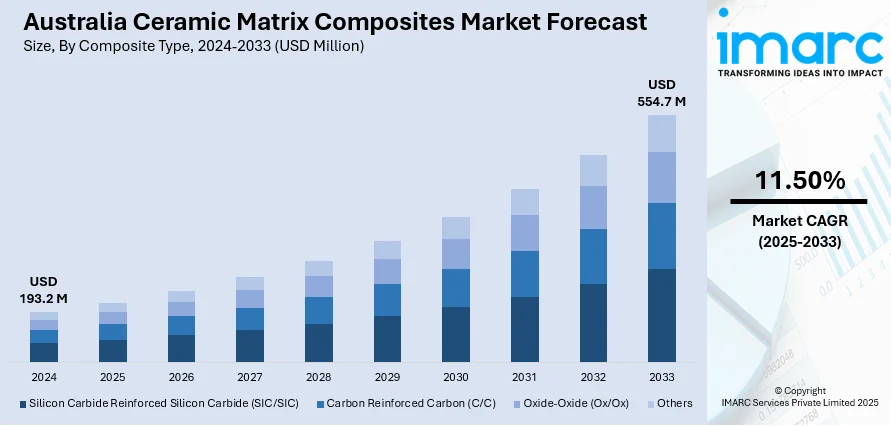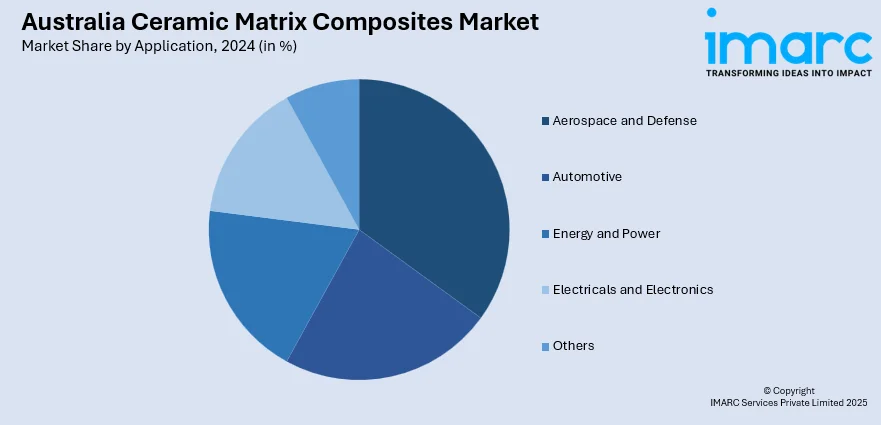
Australia Ceramic Matrix Composites Market Size, Share, Trends and Forecast by Composite Type, Fiber Type, Fiber Material, Application, and Region, 2025-2033
Australia Ceramic Matrix Composites Market Overview:
The Australia ceramic matrix composites market size reached USD 193.2 Million in 2024. Looking forward, IMARC Group expects the market to reach USD 554.7 Million by 2033, exhibiting a growth rate (CAGR) of 11.50% during 2025-2033. The market is growing at a consistent pace with growing demands from aerospace, defense, and industrial applications. Its unparalleled resistance to heat, low weight characteristics, and reliability play a major role in making new technology improvements. Further advances come with additional research and development investments. Since industries demand leading-edge, high-performance materials, the extent of the market just keeps increasing. Players are busy competing against one another to try and hold greater stakes in Australia's ceramic matrix composites share.
|
Report Attribute
|
Key Statistics
|
|---|---|
|
Base Year
|
2024 |
|
Forecast Years
|
2025-2033
|
|
Historical Years
|
2019-2024
|
| Market Size in 2024 | USD 193.2 Million |
| Market Forecast in 2033 | USD 554.7 Million |
| Market Growth Rate 2025-2033 | 11.50% |
Australia Ceramic Matrix Composites Market Trends:
Aerospace and Defense Sector Demand
The defense and aerospace sectors in Australia are major contributors to the ceramic matrix composites market. These industries need materials that can withstand harsh conditions without losing strength and weight. CMCs are best suited for jet engine components, exhaust systems, and structural components in defense systems. Their heat and corrosion resistance makes them a necessity for enhancing performance and safety. Also, government initiatives to enhance national defense capabilities and encourage local production are promoting the use of advanced materials such as CMCs. With the emphasis on fleet modernization and enhancing operational efficiency, the demand for high-performance, long-lasting materials is growing, making CMCs an integral component of this technological shift.

To get more information on this market, Request Sample
Advancements in Manufacturing Technologies
Manufacturing innovations are bringing ceramic matrix composites (CMCs) within reach and increasing their versatility. Processes such as three dimensional (3D) printing and advanced ceramic processing are allowing for the production of complex geometries with increased accuracy and less waste. For instance, studies have shown that C/C-SiC composites can now be manufactured in 3-5 days with less than 5% shrinkage and under 10% porosity, at around 50% of the cost of traditional processes. These developments are enhancing production efficiency, lowering costs, and creating new uses for CMCs across industries like energy, transportation, and heavy industry. New processes also permit the tailoring of CMCs for particular design and performance requirements, prompting wider adoption across industries. As manufacturing methods improve, firms become more capable of incorporating CMCs, contributing to the Australia ceramic matrix composites market growth.
Automotive Industry's Shift Towards Lightweight Materials
In Australia's automotive industry, there is an increasing focus on materials that improve fuel efficiency and minimize emissions. Ceramic matrix composites are becoming increasingly popular as a solution because they are lightweight and strong. They are being implemented in components that are subjected to high stress and heat, like brake systems, engine parts, and exhaust manifolds. With carmakers focusing on designing cars that are not only high-performance but also eco-friendly, CMCs assist in creating a harmony between strength and weight savings. As interest in electric vehicles and environmentally friendly transportation increases, CMCs provide tremendous advantages with respect to thermal stability, wear resistance, and performance, thus becoming a popular material choice in automotive technology.
Australia Ceramic Matrix Composites Market Segmentation:
IMARC Group provides an analysis of the key trends in each segment of the market, along with forecasts at the country and regional levels for 2025-2033. Our report has categorized the market based on composite type, fiber type, fiber material, and application.
Composite Type Insights:
- Silicon Carbide Reinforced Silicon Carbide (SIC/SIC)
- Carbon Reinforced Carbon (C/C)
- Oxide-Oxide (Ox/Ox)
- Others
The report has provided a detailed breakup and analysis of the market based on the composite type. This includes silicon carbide reinforced silicon carbide (SIC/SIC), carbon reinforced carbon (C/C), oxide-oxide (Ox/Ox), and others.
Fiber Type Insights:
- Short Fiber
- Continuous Fiber
A detailed breakup and analysis of the market based on the fiber type have also been provided in the report. This includes short fiber and continuous fiber.
Fiber Material Insights:
- Alumina Fiber
- Refractory Ceramic Fiber (RCF)
- SiC Fiber
- Others
The report has provided a detailed breakup and analysis of the market based on the fiber material. This includes alumina fiber, refractory ceramic fiber (RCF), SiC fiber, and others
Application Insights:

- Aerospace and Defense
- Automotive
- Energy and Power
- Electricals and Electronics
- Others
A detailed breakup and analysis of the market based on the application have also been provided in the report. This includes aerospace and defense, automotive, energy and power, electricals and electronics, and others.
Regional Insights:
- Australia Capital Territory & New South Wales
- Victoria & Tasmania
- Queensland
- Northern Territory & Southern Australia
- Western Australia
The report has also provided a comprehensive analysis of all the major regional markets, which include Australia Capital Territory & New South Wales, Victoria & Tasmania, Queensland, Northern Territory & Southern Australia, and Western Australia.
Competitive Landscape:
The market research report has also provided a comprehensive analysis of the competitive landscape. Competitive analysis such as market structure, key player positioning, top winning strategies, competitive dashboard, and company evaluation quadrant has been covered in the report. Also, detailed profiles of all major companies have been provided.
Australia Ceramic Matrix Composites Market News:
- In Feburary 2024, The Albanese Government is awarding over $3.4 million in grants to 10 innovative Australian defence manufacturers. These 50% matching grants aim to boost local manufacturing, create 50+ skilled jobs, and enhance export capabilities. Projects include counter-drone tech, precision components, and ruggedised electronics. Part of a broader $100M+ initiative, the funding supports priorities from the Defence Strategic Review, strengthening Australia’s sovereign industrial and defence capabilities.
Australia Ceramic Matrix Composites Market Report Coverage:
| Report Features | Details |
|---|---|
| Base Year of the Analysis | 2024 |
| Historical Period | 2019-2024 |
| Forecast Period | 2025-2033 |
| Units | Million USD |
| Scope of the Report | Exploration of Historical Trends and Market Outlook, Industry Catalysts and Challenges, Segment-Wise Historical and Future Market Assessment:
|
| Composite Types Covered | Silicon Carbide Reinforced Silicon Carbide (SIC/SIC), Carbon Reinforced Carbon (C/C), Oxide-Oxide (Ox/Ox), Others |
| Fiber Types Covered | Short Fiber, Continuous Fiber |
| Fiber Materials Covered | Alumina Fiber, Refractory Ceramic Fiber (RCF), SiC Fiber, Others |
| Applications Covered | Aerospace and Defense, Automotive, Energy and Power, Electricals and Electronics, Others |
| Regions Covered | Australia Capital Territory & New South Wales, Victoria & Tasmania, Queensland, Northern Territory & Southern Australia, Western Australia |
| Customization Scope | 10% Free Customization |
| Post-Sale Analyst Support | 10-12 Weeks |
| Delivery Format | PDF and Excel through Email (We can also provide the editable version of the report in PPT/Word format on special request) |
Key Questions Answered in This Report:
- How has the Australia ceramic matrix composites market performed so far and how will it perform in the coming years?
- What is the breakup of the Australia ceramic matrix composites market on the basis of composite type?
- What is the breakup of the Australia ceramic matrix composites market on the basis of fiber type?
- What is the breakup of the Australia ceramic matrix composites market on the basis of fiber material?
- What is the breakup of the Australia ceramic matrix composites market on the basis of application?
- What is the breakup of the Australia ceramic matrix composites market on the basis of region?
- What are the various stages in the value chain of the Australia ceramic matrix composites market?
- What are the key driving factors and challenges in the Australia ceramic matrix composites market?
- What is the structure of the Australia ceramic matrix composites market and who are the key players?
- What is the degree of competition in the Australia ceramic matrix composites market?
Key Benefits for Stakeholders:
- IMARC’s industry report offers a comprehensive quantitative analysis of various market segments, historical and current market trends, market forecasts, and dynamics of the Australia ceramic matrix composites market from 2019-2033.
- The research report provides the latest information on the market drivers, challenges, and opportunities in the Australia ceramic matrix composites market.
- Porter's five forces analysis assist stakeholders in assessing the impact of new entrants, competitive rivalry, supplier power, buyer power, and the threat of substitution. It helps stakeholders to analyze the level of competition within the Australia ceramic matrix composites industry and its attractiveness.
- Competitive landscape allows stakeholders to understand their competitive environment and provides an insight into the current positions of key players in the market.
Need more help?
- Speak to our experienced analysts for insights on the current market scenarios.
- Include additional segments and countries to customize the report as per your requirement.
- Gain an unparalleled competitive advantage in your domain by understanding how to utilize the report and positively impacting your operations and revenue.
- For further assistance, please connect with our analysts.
 Request Customization
Request Customization
 Speak to an Analyst
Speak to an Analyst
 Request Brochure
Request Brochure
 Inquire Before Buying
Inquire Before Buying




.webp)




.webp)












